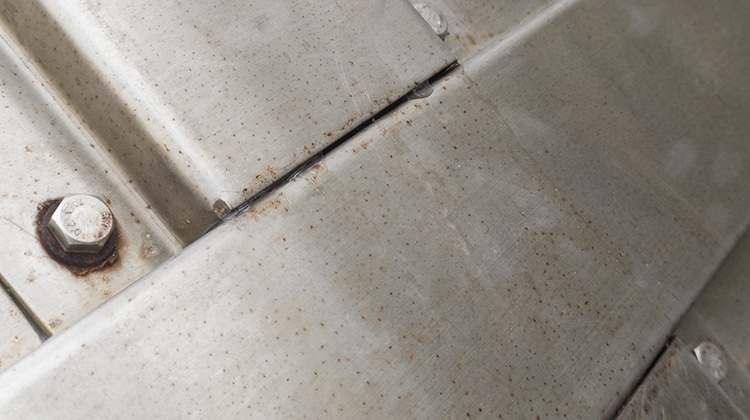
Imagine driving your brand-new EV truck off the lot only to discover rust marks a few months later. According to multiple news outlets, this is precisely what happened to some owners of the new Tesla Cybertruck, a vehicle boasting “an ultra-hard stainless-steel exoskeleton” designed to be indestructible.
However, in this case, seeing is deceiving. As Automotive News and other sources report, the stainless steel isn’t rusting—so what is actually happening? Here, we’ll provide more context around the Tesla situation and discuss the benefits of Armoloy solutions for the passivation of stainless steel across industries and applications.
Deconstructing “Rustgate”
At the beginning of this year, early adopters on the Cybertruck Owners Club forum discussed the mysterious orange flecks that were appearing on their Teslas. The story immediately gained steam: “A new vehicle isn’t supposed to rust within months of leaving the factory…especially if it’s covered in corrosion-resistant stainless steel and costs just shy of six figures,” wrote Bryan Hood of the Robb Report.
It took a Tesla follower’s video, and subsequent confirmation from the company’s head engineer, to solve the mystery of what became known as “rustgate”. Both concluded that small metal deposits, most likely iron, became attached to the trucks in Tesla’s factories or elsewhere during manufacturing. Embedded in the Cybertrucks’ stainless steel exteriors, these specks of metal began to rust when exposed to the elements.
The orange and black marks are easily removed with readily available stainless steel cleaners. However, given that stainless steel is the gold standard for strength, durability, biocompatibility, versatility, and corrosion resistance, how could this issue have been prevented?
The Passivation of Stainless Steel, Interrupted
The terms oxidation and passivation, often cited together, have distinct differences. Oxidation is a general term for the reaction of metals with oxygen to form oxide layers. The oxidation process often spontaneously occurs, such as when metals undergo exposure to oxygen in the air or other oxidizing agents. This process leads to rust or tarnish on the surface of metals like iron, copper, and aluminum. In the case of iron, rust can weaken the metal’s structural integrity and lead to deterioration. However, it’s important to note that not all oxidation processes are harmful.
Passivation, on the other hand, is a deliberate oxidation process that occurs under controlled conditions. A critical step in the manufacturing process, passivation creates a protective layer that ensures long-term durability, aesthetic appeal, and corrosion resistance of stainless steel components.
Now we’re back to the primary question: What caused the orange marks on the Tesla Cybertrucks? The most likely culprit is incomplete or insufficient passivation of the stainless steel ‘exoskeleton.’
Passivation typically involves immersing the stainless steel components in a chemical solution containing an oxidizing agent, such as nitric or citric acid, for a specified period. There are several reasons why the passivation process may fall short of achieving the desired protective layer:
Inadequate processing
If the components aren’t fully immersed or the immersion time is cut short, the protective layer may be incomplete or uneven.
Inadequate agitation or circulation
Proper agitation ensures uniform contact between the passivation solution and the metal surface, facilitating the formation of a consistent oxide layer. This process won’t occur if chemical distribution is uneven across the metal surface.
Improper conditions
Passivation carries out under controlled environmental conditions to minimize factors that could interfere with the process. Temperature, humidity, air quality, ventilation, and filtration can affect the outcome of passivation.
Contamination
Contamination occurs when foreign substances infiltrate the passivation solution or metal surface, interfering with the process.
In the case of Tesla, residue from previous manufacturing processes (likely airborne iron particles) disrupted the passivation process. Subsequently, after leaving Tesla showrooms to brave the elements, the trucks’ stainless steel exteriors began to show signs of rust.
Due in part to its loyal and knowledgeable base, Tesla was able to avert potential public relations problems related to “rustgate.” Regardless of industry or level of social media presence, all manufacturers can benefit from stainless steel passivation solutions.
Rust-Free Rides: Ensuring Proper Passivation of Stainless Steel
By addressing factors that impede proper passivation of stainless steel, manufacturers from the auto industry and beyond can achieve the desired level of corrosion resistance and surface quality.
At Armoloy, we provide different passivation solutions depending on your application needs. Our citric acid-based passivation solutions are environmentally and worker-friendly and ideal for the medical and food and beverage industries. Furthermore, certain military and aerospace specifications may require nitric acid passivation solutions. No matter what option you choose, Armoloy engineers are ready to partner with you against corrosion in all its forms.
